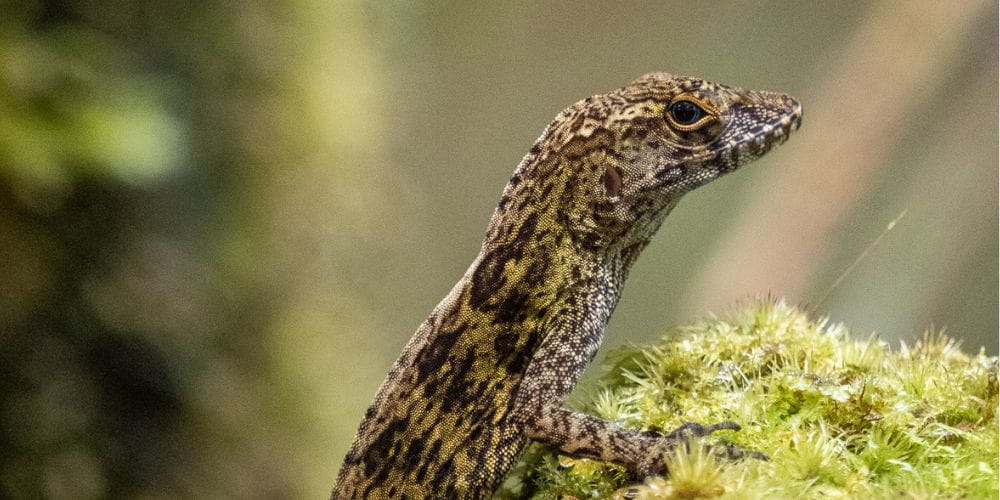UTA research: Wildlife loss five times slower in protected areas
UTA research: Wildlife loss five times slower in protected areas uta.edu


Sustainable Development Goals (SDGs) and Biodiversity Conservation
Wednesday, Sep 27, 2023
Katherine Egan Bennett
Contact
Protecting large areas of land from human activity can help stem the tide of biodiversity loss, especially for vertebrates like amphibians, reptiles, mammals, and birds, according to a new study in Nature.
In particular, vertebrate population declines were five times slower in conservation areas compared to animals living in areas not protected from development or conversion to agricultural use.
“Protected areas take us from a situation in which biodiversity is ebbing away to one where populations are at least close to stable,” said Luke Frishkoff, coauthor of the study and assistant professor of biology at The University of Texas at Arlington. “They buy us much-needed time to figure out how to reverse the biodiversity crisis.”
At these rates, Frishkoff said, populations outside protected areas could see their numbers cut in half in just 40 years. Meanwhile, it would take 170 years for a population in a protected area to undergo the same fate.
Human activity has accelerated the natural extinction rate of vertebrates by a factor of 22. Such biodiversity loss can destabilize food webs and jeopardize the many benefits biodiversity provides humans, such as crop pollination, fuel options, healthy food choices, and disease control.
Research Findings
- Members of the research team included scientists from UTA; the Smithsonian Institution in Washington, D.C.; Conservation International’s Moore Center for Science in Arlington, Virginia; John Carroll University in University Heights, Ohio; the University of California at Davis; and the Zoological Society of London.
- The team captured data from more than 1,000 species spanning every continent except Antarctica.
- The authors examined how 2,239 vertebrate populations fared over time, both inside and outside protected areas.
On average, vertebrate populations declined 0.4% per year inside protected areas—nearly five times slower than vertebrate populations outside of protected areas (1.8% per year). Some vertebrates did better than others, though.
Conservation areas did the most to stabilize amphibian and bird populations. Amphibians, in particular, have been dying in droves due to fungal disease outbreaks and substantial habitat loss, both of which protected areas help to moderate. Reptiles, however, were found to be especially vulnerable in areas of the world that have been most heavily impacted by climate change, regardless of whether they were on protected lands or not.
Interestingly, it wasn’t just being inside a conservation area that helped stabilize wildlife populations. Just being in a country with good governance and low levels of corruption also boosted the prospects of these vertebrates.
“This demonstrates that setting aside land for conservation can make a real difference in preserving animal populations, supporting the notion that increasing conservation areas is an important piece of the puzzle to stem the biodiversity crisis,” Frishkoff said. “However, even if we do increase the amount of protected land, that still leaves the vast majority of Earth’s surface outside protected areas. An average 1.8% decline in population numbers each year is not sustainable. We have to figure out how to stop those declines, too.”
SDGs, Targets, and Indicators Analysis
1. Which SDGs are addressed or connected to the issues highlighted in the article?
- SDG 15: Life on Land
The article discusses the importance of protecting large areas of land to stem the tide of biodiversity loss, particularly for vertebrates. This aligns with SDG 15, which aims to protect, restore, and promote sustainable use of terrestrial ecosystems, sustainably manage forests, combat desertification, halt and reverse land degradation, and halt biodiversity loss.
2. What specific targets under those SDGs can be identified based on the article’s content?
- Target 15.1: By 2020, ensure the conservation, restoration, and sustainable use of terrestrial and inland freshwater ecosystems and their services, in particular forests, wetlands, mountains, and drylands, in line with obligations under international agreements.
- Target 15.5: Take urgent and significant action to reduce the degradation of natural habitats, halt the loss of biodiversity, and protect and prevent the extinction of threatened species.
The article emphasizes the importance of protected areas in conserving biodiversity and slowing down population declines of vertebrates. This aligns with Target 15.1, which focuses on the conservation and sustainable use of terrestrial ecosystems. Additionally, the article highlights the need to protect and prevent the extinction of threatened species, which relates to Target 15.5.
3. Are there any indicators mentioned or implied in the article that can be used to measure progress towards the identified targets?
- Indicator 15.1.1: Forest area as a proportion of total land area
- Indicator 15.5.1: Red List Index
The article mentions that protected areas help stabilize vertebrate populations, indicating progress towards Target 15.1.1, which measures the proportion of forest area as a part of the total land area. The article also discusses the decline in vertebrate populations and the vulnerability of certain species, which can be measured using the Red List Index, an indicator for Target 15.5.1.
SDGs, Targets, and Indicators Table
| SDGs | Targets | Indicators |
|---|---|---|
| SDG 15: Life on Land | Target 15.1: By 2020, ensure the conservation, restoration, and sustainable use of terrestrial and inland freshwater ecosystems and their services, in particular forests, wetlands, mountains, and drylands, in line with obligations under international agreements. | Indicator 15.1.1: Forest area as a proportion of total land area |
| SDG 15: Life on Land | Target 15.5: Take urgent and significant action to reduce the degradation of natural habitats, halt the loss of biodiversity, and protect and prevent the extinction of threatened species. | Indicator 15.5.1: Red List Index |
| Target 15.5: Take urgent and significant action to reduce the degradation of natural habitats, halt the loss of biodiversity, and protect and prevent the extinction of threatened species. | Indicator 15.5.1: Red List Index |
Behold! This splendid article springs forth from the wellspring of knowledge, shaped by a wondrous proprietary AI technology that delved into a vast ocean of data, illuminating the path towards the Sustainable Development Goals. Remember that all rights are reserved by SDG Investors LLC, empowering us to champion progress together.
Source: uta.edu

Join us, as fellow seekers of change, on a transformative journey at https://sdgtalks.ai/welcome, where you can become a member and actively contribute to shaping a brighter future.










